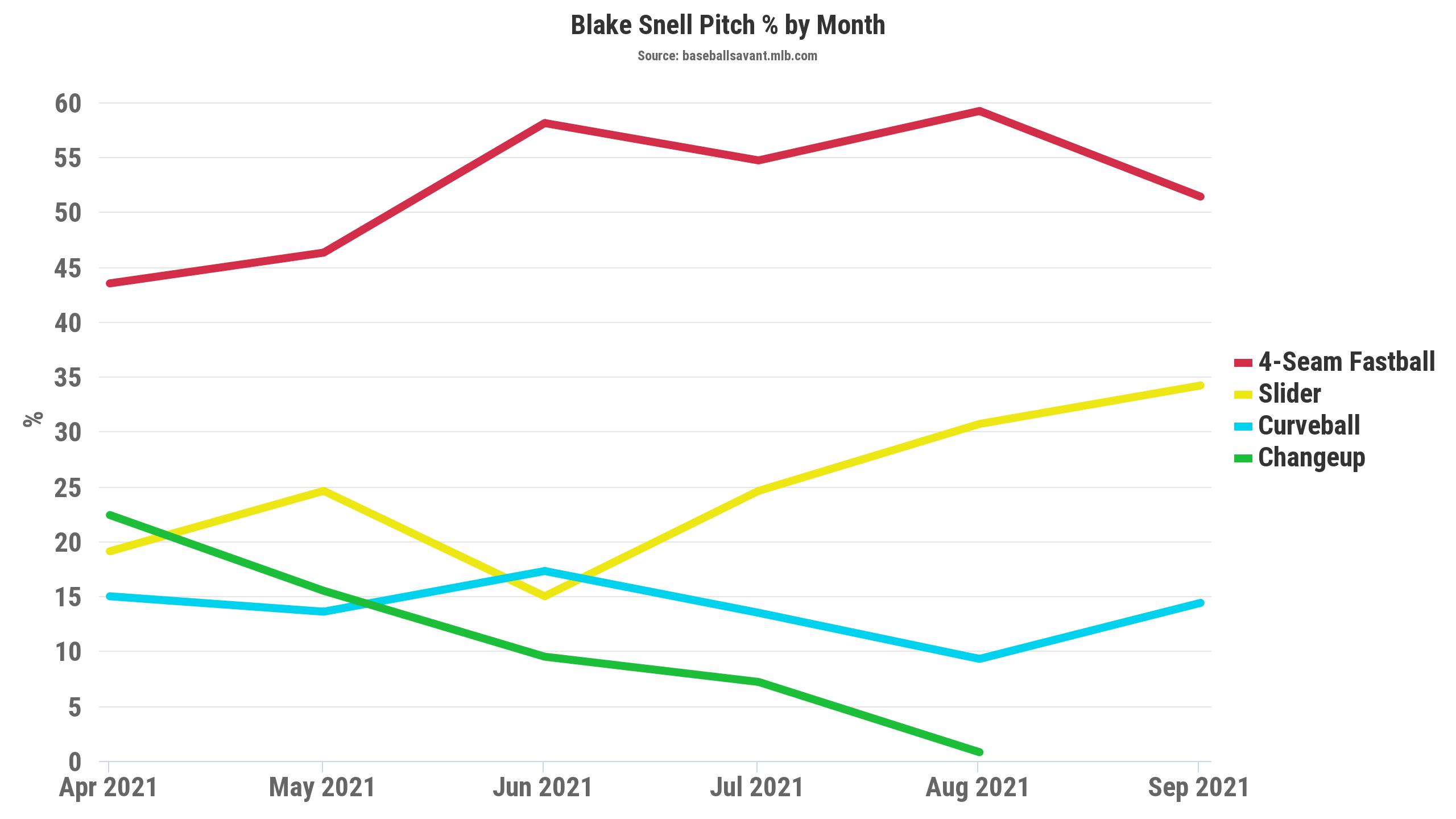The trade that sent Blake Snell to the Padres in the winter of 2020 understandably generated a lot of hype. It was not long after Kevin Cash’s polarizing decision to pull Snell in Game 6 of the World Series, and a popular knee-jerk reaction was that Snell would reach new heights without the constraints of the Rays-gonna-Rays management style. One year later, we know that did not exactly happen. Snell’s 4.20 ERA, 1.32 WHIP, and 12.5% walk rate left something to be desired in his first full year as a Padre (though he did rack up 170 punchouts in 128.2 IP). Within that, however, is a tale of two seasons: four months in which Snell looked like a shell of his former self, followed by a dominant stretch that began in August and ran until a groin injury prematurely ended his season in September.
Snell salvaged his trying 2021 in the late months of the season by embracing a fastball/slider-heavy approach. His success with this strategy was eerily similar to that of one of 2021’s most surprising breakout stars, Robbie Ray. While it may be tempting to think Snell could follow the same path, a closer look reveals that he may need more than his fastball and slider to reclaim ace status.
Brutal Start, Sudden Turnaround
At the beginning of June, Michael Ajeto wrote a piece for Pitcher List diving into what had gone wrong with Snell’s season up to that point. One of Michael’s findings was that Snell had lost the feel for one of his primary weapons, his curveball. Michael connected this deficiency to a change in Snell’s vertical release point that went back to 2020. This trend continued throughout the rest of 2021:

Things got worse for Snell before they got better. He recorded a 5.30 ERA with a paltry 21.0% strikeout rate and a 14.4% walk rate in the rest of June and July. The once-fearsome curveball continued to suffer, as batters recorded a .469 wOBA against it in that span. By the end of July, Snell’s ERA sat at 5.44, and a dreadful 14.3% walk rate countered his solid 27.3% strikeout rate.
When the calendar flipped to August, Snell shook things up. In the first three months of 2021, Snell experimented with different mixes of his secondaries, trying them all out in good measure to look for a winning formula. He slightly dialed back the curve and change in favor of the slider in July, and he pushed harder on this approach in August. He ditched the change entirely and threw even fewer curves, becoming primarily a fastball-slider pitcher. One dramatic example of this was his start against the Diamondbacks on August 8, in which he threw 49% sliders and 48% heaters, ultimately punching out 13 Snakes in seven scoreless innings.

Snell’s fortunes turned when he embraced the fastball-slider lifestyle. From the beginning of August until his September injury, he recorded a 1.83 ERA, a 39.4% strikeout rate, and an 8.5% walk rate with his new plan of attack. It wasn’t the toughest schedule, as he drew three dates with the Snakes and one apiece with the Angels, Phillies, A’s, and Dodgers (excluding the 0.2 IP outing against the Dodgers when he went down with his injury). Even so, numbers like that demand our attention, regardless of schedule. The question is whether Snell’s new approach is sustainable, and to answer that, we now turn our attention to Robbie Ray.
The Robbie-fication of Blake Snell?
I’m probably not the first person to tell you about Ray’s turnaround in 2021, so I’ll keep my recap brief. An essential element of Ray’s success was the re-discovery of his fastball. He upped his four-seam by 12 percent and the rate of fastballs he threw in the zone by 10 percent. With reclaimed zip on the heater (Ray averaged 94.8 mph on the pitch, up from 93.7 mph in 2020), throwing his heater in the zone and daring hitters to get it paid off. Paired with a deadly slider, Ray parlayed his new gameplan into a Cy Young award and a five-year, $115 million payday with the Mariners.
Working mainly with two pitches can be a dangerous gambit for a starter, though. Intentionally throwing more fastballs over the plate is a similarly daring tactic. especially when the approach involves pumping more fastballs over the plate. With these concerns in mind, I want to take a deeper look into whether Snell (or any other arms) has what it takes to pull off the Robbie Ray approach. I’ll be looking for strikeout ability, an effective four-seamer, and a secondary weapon to use as a strikeout pitch (all to be discussed further). I’ll also filter out any starter with an ERA under 3.75 in 2021 to ensure I’m looking at starters who need the help. While a 3.75 ERA certainly isn’t a mark to be ashamed of, it does leave room for improvement.
Strikeout ability: Even in the dregs of Ray’s miserable 2020, he retained the ability to pile up strikeouts. He punched hitters out at a 27.1% clip and posted a 32.9% whiff rate, indicating there was still something in the tank. I’ll start narrowing things down by looking for starters with a strikeout rate in the 65th percentile or higher (about 26%) this past season.
An effective four-seamer: The velocity bump was a key reason Ray was able to throw his fastball so much. For that reason, I’d like to find starters who averaged at least 94 mph on their heaters. I’m also looking only for starters whose four-seamer was the primary fastball type they used. Yu Darvish, for instance, meets all of the above criteria but used his cutter (and his slider) more than his four-seamer in 2021. So far, only a handful of arms check all of the boxes: Snell, Tyler Mahle, Tarik Skubal, Tylor Megill, Nick Pivetta, Huascar Ynoa, and Dylan Cease.
Throwing a fastball hard doesn’t automatically make it effective. We also need evidence that these guys can throw heaters in the zone without getting clobbered. For that reason, I’m striking Ynoa and Cease from the list — their CSW marks of 25.4% and 25.3% on their fastballs, respectively, aren’t going to cut it. Neither will Skubal’s heater and the .413 wOBA hitters recorded against it this past season. That leaves us with Snell, Megill, Pivetta, and Mahle.
Of these four arms, Snell is arguably the best candidate to be Robbie-fied. Megill’s fastball usage already resembles what Ray did in ’21, as Megill threw his heater 57 percent of the time last season and pumped it in the zone just under 60 percent of the time. It’s tough to say the Robbie approach could make Megill successful when he’s already embracing a big part of that approach with much less to show for it. Megill also faces a playing time pinch, as many projections have him penciled in for a bit more than 100 innings this coming season.
Pivetta’s heater doesn’t exactly strike fear into opposing hitters’ minds — 27.2% CSW, .340 wOBA — and he may also lack a dominant secondary offering to use as a strikeout pitch. His curveball and its 39.3% strikeout rate might seem like a good candidate, but its measly 26.4% whiff rate doesn’t back up that strikeout success. For context, Ray posted a 48% strikeout rate and a 45.8% whiff rate with his slider. The bar doesn’t need to be that high, but the whiff ability of Pivetta’s curve last year suggests it may not be a strong enough weapon to sustain a two-pitch approach.
Finally, in Mahle’s case, what might need improvement more than anything else are the dimensions of his home park. His splitter and slider aren’t the most compelling secondaries, but his home/road splits are an equally glaring obstacle. While his xFIP was very similar at home versus on the road (3.63 at home, 3.82 on the road), his ERA was over three runs higher at Great American Ball Park (5.63 at home, 2.30 away). Offering up more heaters in the zone when hitters are already tagging him at home might not be the best path forward for Mahle to move past being a high-3’s ERA guy.
With all of that, we’re left with Snell as the best possible candidate to be Robbie-fied in 2022. Both lefties showed great strikeout ability this past season and had similar profiles on their heaters:
In addition to his strikeout ability and fastball profile, the performance of Snell’s slider makes the Robbie approach very intriguing. Both lefties’ sliders were dominant and served as essential pieces of their successes in 2021:
Hitting the Brakes on the Hype Train
Before declaring that mimicking Ray has enabled Snell to reclaim ace status, we need to acknowledge a significant factor in his late-season surge: luck.
Snell’s luck may have swung in the wrong direction early on, but good fortune clearly played a role in his turnaround. In particular, the fastball dramatically overperformed in that stretch (a .182 wOBA vs. a .303 xwOBA). Here is also where it’s necessary to acknowledge strength-of-schedule. Snell’s ERA in those starts still would have been impressive had it matched his 2.94 xFIP in that time, but dates with more dangerous opponents inevitably would have dragged that mark higher. For these crucial reasons, it would be wise not to buy too much into a small sample of success when evaluating Snell’s potential in 2022. It wasn’t an accident that the above methodology returned so few candidates; what Robbie did in 2021 is not easy to pull off. Snell’s slider is a legit weapon and the heater gets the job done, so using those two pitches as a base is more than adequate. However, the best path for Snell to enjoy a true bounceback is for the curve to come back as a viable third pitch. Opponents’ wOBA against Snell’s curve in August was .285, the lowest of any month in Snell’s 2021, but even sustaining that mark over a full season would be a far cry from years past when the hook recorded a wOBA in the low-.200s.
An Unclear Forecast
Snell’s NFBC ADP at the time of writing this article is 115, putting him in the company of names such as Mahle, Shane McClanahan, Justin Verlander, and Pablo López. All of those arms offer good upside but come with question marks that may very well hold them back. Snell’s punchout ability is evident, but his ratios are tougher to pinpoint. 2021 proved there is a definite gap between Snell’s ceiling and floor, and where he lands may depend heavily on whether the hook comes back.
Snell’s first half may have been scary, but with his fastball and slider as a base, it’s tough to think he could be significantly worse than last year’s 4.20 ERA and 1.32 WHIP. The key for fantasy managers is not to overpay for the perceived ceiling. Many projections have him penciled in for an ERA in the neighborhood of 3.70 and a WHIP right around his career average of 1.25. This basic profile makes him an arm to target as an upside play in a fantasy staff that already has a bona fide ace (and maybe ideally a No. 2 with a more certain floor). Stretches of dominance like the back end of 2021 may come, but it would be best not to expect that they are the new norm.
Photo by Randy Litzinger/Icon Sportswire | Adapted by Justin Redler (@reldernitsuj on Twitter)

